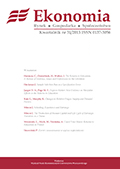Applying Exogenous Variables and Regime
Switching to Multi-Factor Models on Equity Indices
P. Sakowski, R. Ślepaczuk, M. Wywiał
ABSTRAKT: This article aims to extend the evaluation of classic multi-factor models of Carhart (1997) and to expand analysis performed in Sakowski, Ślepaczuk and Wywiał (2015). We test several modifications of these models to take into account different dynamics of equity excess returns between emerging and developed equity indices. Proposed extensions include volatility regime switching mechanism and three new risk factors. Additionally, we introduce common- and country-specific variables in order to control for global risk. Instead of individual stocks, we use weekly data of 81 world investable equity indices in the period of 2000−2015. We find substantial differences between results for classical models on single stocks and models evaluated for equity indices. Moreover, we observe solid discrepancies between results for developed and emerging markets. Introducing new risk factors and additional variables increase explanatory power of models.
Pełny tekst (PDF)
Numer wydania: 47
W numerze:
Underestimated or Overestimated: Matching Funtion Elasticities Biased Due to Worker Inflows and Outflows
E. Gałecka-Burdziak
ABSTRAKT |
PDF
Matching function elasticities are biased, that is, underestimated or overestimated, if inflows and outflows of job seekers are omitted. I analyse mathematically the direction of this bias and estimate parameters for random, stock-flow and job queuing models, adjusted econometrically for the temporal aggregation bias in the data. I analyse various sets of endogenous and exogenous variables from registered unemployment data in Poland. Estimates show that unemployment affects matching more than discouragement, and that unemployment stock elasticity is underestimated if discouraged workers are neglected.
Do Entrants Take It All? The Evolution of Task Content of Jobs in Poland
W. Hardy, R. Keister, P. Lewandowski
ABSTRAKT |
PDF
In this paper we analyse the changes in task content of jobs in Poland between 1996 and 2014. We follow the approach of Autor, Levy and Murnane (2003) and Acemoglu and Autor (2011) and use the O*NET 2003 and 2014 data combined with the Polish LFS data at a 4-digit occupation classification. We find an increasing intensity of both non-routine and routine cognitive tasks, and a decreasing intensity of both routine and non-routine manual tasks, mainly due to shifts in the employment structure between occupations. Cohorts born after 1970 underwent large shifts in the task intensity structure and contributed most to the overall changes in task contents, while almost no adjustments occurred in cohorts born before 1970. The growth of non-routine cognitive tasks among workers born after the 1970 was largely driven by the tertiary education boom in Poland, although in some cohorts the rising supply of tertiary graduates was accompanied by a relative reduction of the non-routine content of jobs.
Does It Pay to Invest in the Education of Children?
J. Liwiński, E. Bedyk
ABSTRAKT |
PDF
The work described here sought to determine whether parents’ investment in the education of children in Poland has an impact on the wages of the latter in adulthood. To answer this question, an extended Mincer wage equation was estimated using OLS on the basis of data from the nationwide tracer survey of Polish graduates conducted in 2007. Analysis shows that parental investment in the education of children has a strong, positive impact on first earnings after the end of formal education. This relationship is to be observed when the investment is depicted with educational level of each parent, as well as when represented by the child’s participation in various extracurricular activities. Furthermore, if any of the above measures of parental investment is included in the equation, the wage premium from each level of formal education decreases. In particular, when both these measures of parental investments are included in the model, the tertiary education premium declines by about one quarter, while secondary vocational or general education are no longer significant determinants of the graduates’ wages (as compared with basic vocational education).
Applying Exogenous Variables and Regime
Switching to Multi-Factor Models on Equity Indices
P. Sakowski, R. Ślepaczuk, M. Wywiał
ABSTRAKT |
PDF
This article aims to extend the evaluation of classic multi-factor models of Carhart (1997) and to expand analysis performed in Sakowski, Ślepaczuk and Wywiał (2015). We test several modifications of these models to take into account different dynamics of equity excess returns between emerging and developed equity indices. Proposed extensions include volatility regime switching mechanism and three new risk factors. Additionally, we introduce common- and country-specific variables in order to control for global risk. Instead of individual stocks, we use weekly data of 81 world investable equity indices in the period of 2000−2015. We find substantial differences between results for classical models on single stocks and models evaluated for equity indices. Moreover, we observe solid discrepancies between results for developed and emerging markets. Introducing new risk factors and additional variables increase explanatory power of models.
Aggregation with a Double Non-Convex Labor Supply Decision: Indivisible Private- and Public-Sector Hours
A. Vasilev
ABSTRAKT |
PDF
This paper explores the problem of non-convex labor supply decisions in an economy with both private and public sector jobs. To this end, Hansen (1985) and Rogerson’s (1988) indivisible-hours framework is extended to an environment featuring a double discrete labor choice. The novelty of the study is that the micro-founded representation obtained from explicit aggregation over homogeneous individuals features different disutility of labor across the two sectors, which is in line with the observed difference in average wage rates (OECD 2011). Therefore, this theory-based utility function could be utilized to study labor supply responses over the business cycle.
Revisiting Conventional Wisdom: Does Financialization Have to Leave Sovereigns Subordinated?
A. Ząbkowicz, S. Czech
ABSTRAKT |
PDF
The financialization process is considered to leave debtor states critically dependent on international financial capital, which may then exercise indirect power over government policy, to the point where the state becomes a hostage to financial markets’ ‘state of confidence’. Such relations between the state and internationalized capital are perceived to come with two strings attached, as the state listens to financial markets because it is in debt and must settle accounts while still requiring external financing; and as financial deepening or credit is considered a vehicle of economic growth. It is the contention of this paper that conventional wisdom as to the correctness of debtor-state behavior in the above circumstances is open to challenge.

